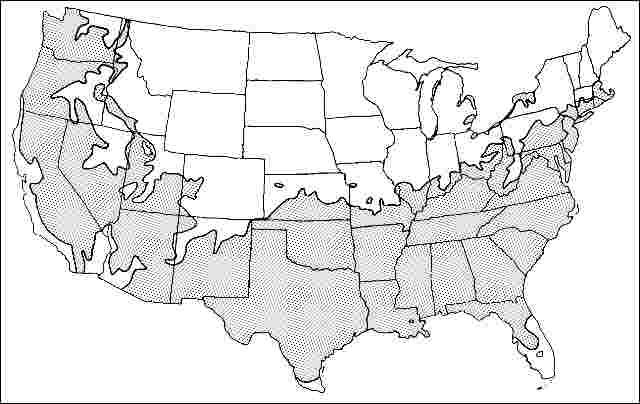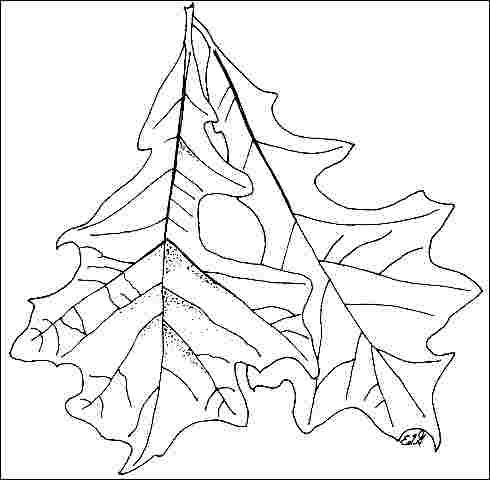Introduction
Overcup oak grows slowly, sometimes to more than 100 feet in height in its native habitat but is more often seen 30 to 40 feet high and wide, forming a rounded silhouette with an open crown, large-diameter branches, and a twisted trunk. The dark green, leathery, lobed leaves have fuzzy, white undersides and turn a rich brown color before dropping in fall. The nuts or acorns which are produced are quite popular with squirrels, turkeys, wild hogs and deer. The rough, reddish or gray/brown bark is attractive and is worthy of display with night-time lighting.

Credit: Ed Gilman, UF/IFAS
General Information
Scientific name: Quercus lyrata
Pronunciation: KWERK-us lye-RAY-tuh
Common name(s): Overcup oak
Family: Fagaceae
USDA hardiness zones: 6A through 9A (Fig. 2)
Origin: native to North America
Invasive potential: little invasive potential
Uses: reclamation; sidewalk cutout (tree pit); street without sidewalk; shade; parking lot island > 200 sq ft; tree lawn > 6 ft wide; highway median
Availability: not native to North America

Description
Height: 30 to 40 feet
Spread: 30 to 40 feet
Crown uniformity: symmetrical
Crown shape: oval, round
Crown density: moderate
Growth rate: moderate
Texture: medium
Foliage
Leaf arrangement: alternate (Fig. 3)
Leaf type: simple
Leaf margin: entire, lobed
Leaf shape: oblong, obovate
Leaf venation: pinnate
Leaf type and persistence: deciduous
Leaf blade length: 4 to 8 inches
Leaf color: green
Fall color: copper
Fall characteristic: not showy

Flower
Flower color: brown
Flower characteristics: not showy
Fruit
Fruit shape: round
Fruit length: .5 to 1 inch
Fruit covering: dry or hard
Fruit color: brown
Fruit characteristics: attracts squirrels/mammals; showy; fruit/leaves a litter problem
Trunk and Branches
Trunk/bark/branches: branches don't droop; not showy; typically one trunk; thorns
Pruning requirement: little required
Breakage: resistant
Current year twig color: gray, brown
Current year twig thickness: thick
Wood specific gravity: 0.63
Culture
Light requirement: partial sun, partial shade, or full sun
Soil tolerances: clay; sand; loam; acidic; slightly alkaline; extended flooding; well-drained
Drought tolerance: moderate
Aerosol salt tolerance: unknown
Other
Roots: not a problem
Winter interest: no
Outstanding tree: no
Ozone sensitivity: unknown
Verticillium wilt susceptibility: resistant
Pest resistance: resistant to pests/diseases
Use and Management
This oak should be grown with a single trunk and a few widely-spaced branches to mimic its growth habit in the wild. The first permanent branch can be located three to five feet from the ground if the tree will be planted in an open lawn area and allowed to develop a wide crown. For those planted as street trees or in areas requiring clearance for vehicles or pedestrians, the first permanent branch should be higher on the trunk. The interior portion of the crown often cleans itself of small branches, displaying the nice branch arrangement common on most specimens.
Overcup oak should be grown in full sun or partial shade on almost any soil, tolerating wet, poorly drained sites or acid, sandy soils. It would be well suited for planting in poorly-drained urban sites, but is not normally available at landscape nurseries.
Pests and Diseases
No pests or diseases of major concern.